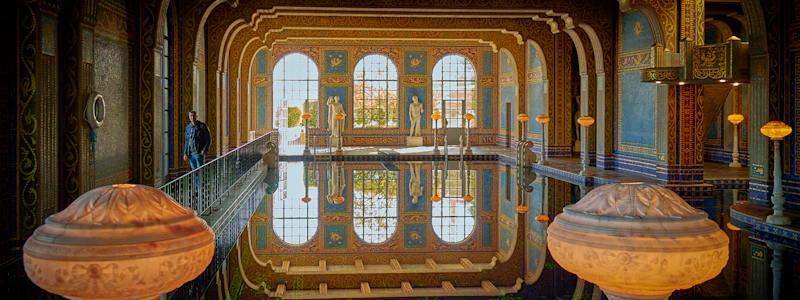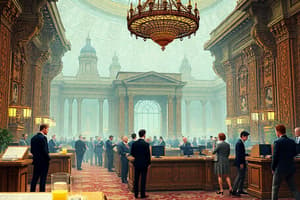Podcast
Questions and Answers
Which of the following is NOT a key component of the Bureaucracy?
Which of the following is NOT a key component of the Bureaucracy?
- Cabinet Departments
- Political Parties (correct)
- Independent Regulatory Agencies
- Government Corporations
What is the primary function of the Bureaucracy?
What is the primary function of the Bureaucracy?
- To interpret the Constitution
- To represent the interests of the people
- To create and pass laws
- To ensure the implementation of laws (correct)
Which agency is responsible for overseeing the stock market?
Which agency is responsible for overseeing the stock market?
- Department of Homeland Security
- Environmental Protection Agency (EPA)
- Securities and Exchange Commission (SEC) (correct)
- Federal Trade Commission (FTC)
What is an example of discretionary authority exercised by a bureaucratic agency?
What is an example of discretionary authority exercised by a bureaucratic agency?
What is the difference between an 'Iron Triangle' and an 'Issue Network'?
What is the difference between an 'Iron Triangle' and an 'Issue Network'?
How do bureaucratic agencies gain power?
How do bureaucratic agencies gain power?
What is an example of an agency's rulemaking authority?
What is an example of an agency's rulemaking authority?
Which of the following is NOT a task performed by the Bureaucracy?
Which of the following is NOT a task performed by the Bureaucracy?
Which of the following is NOT a formal power that the President can use to influence the bureaucracy?
Which of the following is NOT a formal power that the President can use to influence the bureaucracy?
What is the main purpose of the Merit System, as implemented by the Pendleton Act?
What is the main purpose of the Merit System, as implemented by the Pendleton Act?
In the context of the Iron Triangle, which of these groups would be considered the "interest group"?
In the context of the Iron Triangle, which of these groups would be considered the "interest group"?
How does Congressional Oversight help keep the bureaucracy accountable?
How does Congressional Oversight help keep the bureaucracy accountable?
Which of the following is considered a key agency focused on regulating the stock market and financial disclosures?
Which of the following is considered a key agency focused on regulating the stock market and financial disclosures?
What is the main purpose of Compliance Monitoring by government agencies?
What is the main purpose of Compliance Monitoring by government agencies?
What is a potential consequence of inconsistent enforcement of regulations by a government agency?
What is a potential consequence of inconsistent enforcement of regulations by a government agency?
Which of the following would be an example of a bureaucratic agency's actions being deemed unconstitutional by the courts?
Which of the following would be an example of a bureaucratic agency's actions being deemed unconstitutional by the courts?
Which of the following is an example of how Congress can check the power of the Supreme Court?
Which of the following is an example of how Congress can check the power of the Supreme Court?
How did the Civil Rights Act of 1964 act as a check on the judicial branch?
How did the Civil Rights Act of 1964 act as a check on the judicial branch?
What is an example of a check on the Supreme Court's power that involves the President?
What is an example of a check on the Supreme Court's power that involves the President?
What is a key difference between strict constructionism and loose constructionism?
What is a key difference between strict constructionism and loose constructionism?
Which of the following is NOT a check on the power of the Judicial Branch?
Which of the following is NOT a check on the power of the Judicial Branch?
What is the primary function of the judicial branch of the government, as outlined in the content?
What is the primary function of the judicial branch of the government, as outlined in the content?
What document establishes the Supreme Court and gives Congress the authority to create lower courts?
What document establishes the Supreme Court and gives Congress the authority to create lower courts?
What is the primary argument presented in Federalist No. 78, written by Alexander Hamilton?
What is the primary argument presented in Federalist No. 78, written by Alexander Hamilton?
What landmark Supreme Court case established the principle of judicial review?
What landmark Supreme Court case established the principle of judicial review?
What does the phrase "Stare decisis" mean in the context of judicial decision-making?
What does the phrase "Stare decisis" mean in the context of judicial decision-making?
How can changes in the composition of the Supreme Court affect the interpretation of laws and rights?
How can changes in the composition of the Supreme Court affect the interpretation of laws and rights?
What is the main difference between judicial activism and judicial restraint?
What is the main difference between judicial activism and judicial restraint?
Which of the following Supreme Court decisions is an example of a controversial decision that impacted public trust in the judiciary?
Which of the following Supreme Court decisions is an example of a controversial decision that impacted public trust in the judiciary?
Flashcards
The Bureaucracy
The Bureaucracy
The government structure that implements and manages policies through federal departments and agencies.
Cabinet Departments
Cabinet Departments
Major divisions of the bureaucracy responsible for specific policy areas, like Homeland Security.
Independent Regulatory Agencies
Independent Regulatory Agencies
Government organizations created to regulate specific activities, free from executive control, such as the SEC.
Government Corporations
Government Corporations
Signup and view all the flashcards
Discretionary Authority
Discretionary Authority
Signup and view all the flashcards
Rulemaking Authority
Rulemaking Authority
Signup and view all the flashcards
Iron Triangles
Iron Triangles
Signup and view all the flashcards
Issue Networks
Issue Networks
Signup and view all the flashcards
Loose Constructionism
Loose Constructionism
Signup and view all the flashcards
Strict Constructionism
Strict Constructionism
Signup and view all the flashcards
Checks on the Judicial Branch
Checks on the Judicial Branch
Signup and view all the flashcards
Congressional Legislation
Congressional Legislation
Signup and view all the flashcards
Judicial Appointments
Judicial Appointments
Signup and view all the flashcards
Political Patronage
Political Patronage
Signup and view all the flashcards
Pendleton Act
Pendleton Act
Signup and view all the flashcards
Merit System
Merit System
Signup and view all the flashcards
Presidential Control
Presidential Control
Signup and view all the flashcards
Congressional Oversight
Congressional Oversight
Signup and view all the flashcards
Compliance Monitoring
Compliance Monitoring
Signup and view all the flashcards
Judicial Review of Bureaucracy
Judicial Review of Bureaucracy
Signup and view all the flashcards
Judicial Branch
Judicial Branch
Signup and view all the flashcards
Supreme Court
Supreme Court
Signup and view all the flashcards
Judicial Review
Judicial Review
Signup and view all the flashcards
Stare Decisis
Stare Decisis
Signup and view all the flashcards
Judicial Activism
Judicial Activism
Signup and view all the flashcards
Judicial Restraint
Judicial Restraint
Signup and view all the flashcards
Precedent
Precedent
Signup and view all the flashcards
Federalist No. 78
Federalist No. 78
Signup and view all the flashcards
Study Notes
The Bureaucracy
- The bureaucracy implements government policy through federal departments, agencies, commissions, and government corporations.
- Key components include cabinet departments (e.g., Department of Homeland Security, Department of Transportation), independent regulatory agencies (e.g., Securities and Exchange Commission, Federal Elections Commission), government corporations (e.g., Amtrak, U.S. Postal Service), and executive agencies (e.g., Environmental Protection Agency).
- The bureaucracy carries out laws through government agencies, commissions, and departments.
- Examples include the Department of Homeland Security managing border security, the Environmental Protection Agency enforcing environmental laws, and the Securities and Exchange Commission overseeing the stock market.
- Bureaucratic tasks include writing and enforcing legislation, issuing fines for violations, and testifying before Congress.
- Bureaucratic agencies have relationships with congressional committees and interest groups, forming "iron triangles" (strong, stable relationships) and "issue networks" (looser, dynamic coalitions with academics, media, and policy advocates).
- Discretionary authority allows some agencies to decide how best to enforce laws.
Main Tasks of the Bureaucracy
- Agencies create detailed rules to implement laws passed by Congress.
- Agencies penalize individuals or corporations that violate regulations (e.g., SEC and EPA).
- Bureaucrats provide expertise during congressional hearings.
Holding the Bureaucracy Accountable
- Historically, government jobs were given as political favors (spoils system).
- The Pendleton Act (1883) introduced a merit-based hiring system, reducing political influence.
- Presidential control of agencies involves appointing heads, issuing executive orders, and influencing budget requests.
- Congress oversees agencies with hearings, controlling budgets, and passing new laws to restrict them.
- Courts can strike down agency actions if deemed unconstitutional or exceeding their powers.
Judicial Branch
- The judicial branch interprets and applies laws.
- Article III establishes the Supreme Court and allows Congress to create lower courts.
- The Supreme Court is the highest court and has final say on constitutional issues.
- Judicial review allows courts to declare laws and executive actions as unconstitutional.
- Article III establishes the Supreme Court and gives Congress the power to create lower courts.
- Judges serve for life with good behavior, ensuring independence.
- The judiciary is considered the "least dangerous" branch because it cannot enforce its rulings, but is crucial in protecting rights.
- Marbury v. Madison (1803) established judicial review, creating co-equal status for the court.
- Stare decisis ("let the decision stand") guides future decisions
- Supreme Court Justices are appointed by the President and confirmed by the Senate.
- Political ideology of justices influences Court decisions.
- Court decisions can be controversial, impacting public trust. Examples include Brown v. Board of Education (1954) and Roe v. Wade (1973).
Checks on the Judicial Branch
- Congress can pass legislation to modify the impact of previous decisions.
- Congress can pass new laws, like the Civil Rights Act of 1964.
- Constitutional amendments can overturn court decisions, like the 13th Amendment.
- Presidents nominate Justices, but the Senate confirms them.
- Judicial appointments and confirmations involve political considerations.
- Presidents and states may evade decisions.
- Congress can influence the jurisdiction of the courts to limit cases they hear (i.e. Congress passes legislation to limit the types of cases heard in Court).
Studying That Suits You
Use AI to generate personalized quizzes and flashcards to suit your learning preferences.




